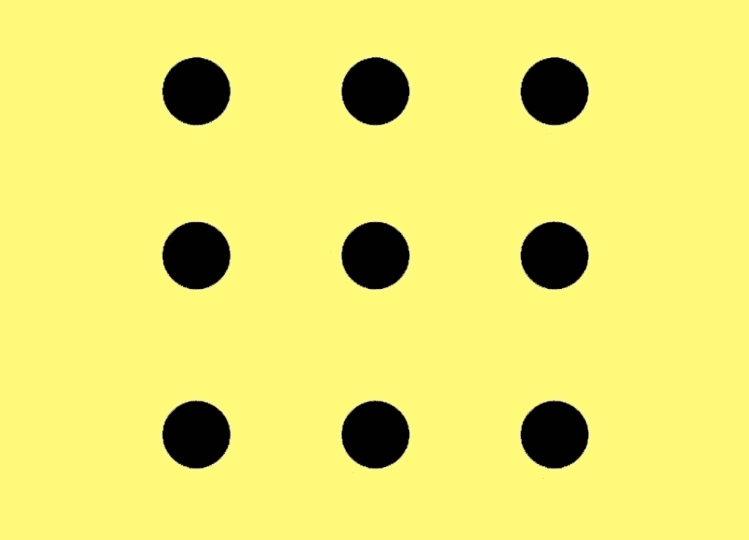Imagine facing a simple but mind-bending puzzle: nine dots arranged in a three-by-three grid. Your challenge? Connect all nine dots with just four straight lines – and here’s the catch – you can’t lift your pen from the paper. It sounds straightforward, but this puzzle has stumped people for years. Are you ready to put your logic skills to the test? Grab a piece of paper, a pen, and let’s dive into the solution together. Ready to challenge your thinking? Let’s go!
Why This Puzzle Is Trickier Than It Looks

This puzzle is not about the dots themselves but rather about how we tend to impose invisible limits on our thinking. Most people approach this challenge by mentally boxing themselves into the square formed by the outer dots. However, the solution requires thinking beyond those imaginary boundaries – or, quite literally, thinking outside the box.
When we tackle this puzzle, we often assume we need to stay within the confines of the dots, which leads to dead ends. This tendency to restrict ourselves makes the puzzle a perfect exercise for breaking out of conventional thought patterns.
Common Mistakes People Make When Solving the Puzzle
People often make the following mistakes when attempting to connect all nine dots:
- Sticking to the Grid: Most people assume the lines have to stay within the imaginary boundary created by the dots, which leads to a closed-off mindset.
- Using Too Many Lines: Some try using more than four lines, mistakenly thinking this is necessary to cover all dots.
- Making Sharp Turns: Instead of creating a continuous flow, they include sharp turns that prevent them from reaching all the dots within the limited number of lines.
- Using Curved Lines: Some get so desperate that they resort to curved lines, which don’t adhere to the puzzle’s requirement of straight lines.
The solution requires abandoning these mental constraints and embracing a more open, flexible way of thinking.
Step-by-Step Solution: How to Connect All Nine Dots with Four Lines
Let’s go through the solution step-by-step. Remember, the key to solving this puzzle is to extend your lines beyond the boundary of the dots. Here’s how you do it:
Step 1: Start at the Top Left Dot
Place your pen on the top-left dot. From here, draw a straight line diagonally down to the bottom-right dot. This line should pass through the middle dot in the center row, covering three dots in total.
Step 2: Continue to the Bottom Left Dot
Next, continue the line from the bottom-right dot and extend it horizontally to the bottom-left dot. This simple move allows you to connect three more dots without lifting your pen.
Step 3: Draw Upward to the Top Right Dot
From the bottom-left dot, draw a line diagonally upward to the top-right dot. This line will intersect with the middle dot in the center row, covering all three dots in this line. Now, you have connected a total of six dots.
Step 4: Complete the Connection with a Horizontal Line
Finally, from the top-right dot, draw a straight line across to the left, passing through the top-left dot and extending slightly beyond the grid. This last line covers the remaining three dots, completing the puzzle with only four straight lines.

The reason this solution works is because it requires you to abandon the invisible box around the dots. By extending the lines beyond the boundary, you achieve a continuous connection that covers all nine dots with the specified number of lines. This approach forces you to push past the conventional thinking patterns and illustrates the power of thinking outside the box.
This puzzle is a perfect metaphor for the way we sometimes limit ourselves with invisible boundaries. In life, we often impose restrictions on our own thinking, assuming there are limits when there are none. By challenging these assumptions, we can uncover creative solutions to problems that initially seem unsolvable.
Breaking free from these self-imposed boundaries encourages innovative thinking, helps you approach challenges from fresh perspectives, and boosts your problem-solving abilities. Whether it’s a puzzle like this or a real-world challenge, the nine-dot puzzle reminds us that the solution might just lie outside the lines.
The 9-dot puzzle with 4 straight lines is a classic example of how stepping outside of your mental boundaries can lead to unexpected solutions. The next time you face a difficult problem, whether it’s a puzzle or a real-life challenge, ask yourself if you’re confining yourself to an invisible box. Sometimes, all it takes is a shift in perspective to find the answer.
So go ahead, challenge yourself to think differently, and remember that the best solutions are often the ones that break the rules you didn’t know you were following. Happy puzzling, and don’t forget – life, much like this puzzle, is best approached without limits!


